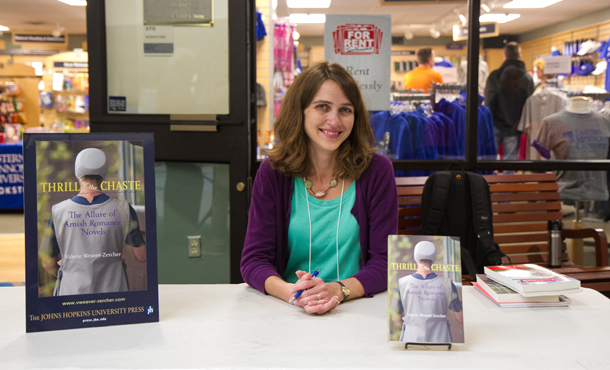Amish “bonnet rippers” have become massively popular in the past decade, Valerie Weaver-Zercher told an audience of fellow-alumni and faculty during Homecoming 2013 at Eastern Mennonite University, Oct. 11-13.
A new Amish romance is published about every four days, with at least 86 released in 2012, said Weaver-Zercher at a Saturday morning talk sponsored by EMU’s language and literature department.
She herself had never read an “Amish romance” until Johns Hopkins University Press approached Weaver-Zercher, suggesting she investigate this burgeoning market. That led to Weaver-Zercher’s first published book, Thrill of the Chaste: The Allure of Amish Romance Novels (2013).
No explicit sexual description
Even within the Anabaptist world, the books are widely read, despite their questionable authenticity. Weaver-Zercher, a ’94 grad who majored in English, mostly focused on why people are reading this genre, rather than delving deeply into the books’ accuracy or literary quality.
She interviewed several Amish romance authors and numerous readers – mostly non-Amish, evangelical women – who cited two basic appeals of the books: evocation of “a slow and simple life,” and “a clean read” (i.e., no sexual explicitness).
Her audience laughed when Weaver-Zercher elaborated that a love scene within the genre “might be some romantic glances over a pot pie.”
Although the Amish comprise only one-tenth of 1 percent of the U.S. population, the genre is well-covered in the mainstream media, including a recent Wall Street Journal article by Weaver-Zercher, who is also managing editor at Herald Press and a contributing editor for Sojourners.
At her presentation, several alumni, whose student years dated from the 1950s to the 2000s, named as a favorite the recently reprinted Rosanna of the Amish by Joseph W. Yoder, a Mennonite author who penned a semi-fictional account of his mother, first published in 1940.
One million book sales, plus TV dramatization
Weaver-Zercher noted the first commercially successful contemporary Anabaptist-themed romance, Beverly Lewis’ 1997 The Shunning, published by Bethany House and dramatized on television, has sold over a million copies. Its heroine endures ostracism after finding she was adopted.
Lewis, who based the character on her Mennonite grandmother, ranks with Wanda Brunstetter and Cindy Woodsmall among the genre’s top three authors, who together have sold more than 24 million books. Yet only one current Amish romance author, Linda Byler, is Amish or Old Order Mennonite (the two branches of Anabaptists share more similarities than differences) – which Weaver-Zercher notes engenders skepticism about the field’s authenticity.
The genre’s female protagonists tend to be virgins or young wives; the men, earnest and sensitive, Weaver-Zercher notes. At least four authors are men, and Weaver-Zercher found an elderly, Oklahoma Mennonite farmer who has read 90 Amish romances.
In her Wall Street Journal article, Weaver-Zercher said some authors blend “a divine love story” with the earthly one. She cited a sentence in Brunstetter’s The Hope Chest in which a young woman, being kissed, finds herself “reveling in God’s glory.”
Gentle mysteries tucked in
“Some authors add gentle mysteries along with the romance narrative,” said Weaver-Zercher. Byler’s series, Lancaster Burning, portrays a community plagued by arson.
Weaver-Zercher finds “distinctive styles” among some authors, unlike the formulaic products of some mainstream romance publishing houses. However, they follow parameters common to “Christian fiction” – although a “false hero” sometimes appears, endings are always happy.
“The ‘thrill of the chaste’ may be rooted in the broader idea of moral innocence – a rejection of the mass culture,” said Weaver-Zercher.
She suggested the novels exemplify a “purity culture” in reaction to what Pamela Paul’s book Pornified terms today’s mass culture. They may also, Weaver-Zercher suggested, be seen as “a Christian version of “The Way We Never Were,” referring to the title of an analysis of the American family by Stephanie Coontz.
Pointing to what French theorist Gilles Lipovetsky has labeled “hypermodernity” – a rushed, materialistic, technology-dominated culture – Weaver-Zercher added with a smile that the books give readers “a temporary vacation from hypermodernity, even when they read them on Kindles or Nooks.”
Ironically, however, she noted Amish romances are “situated smack-dab in hypermodern publishing models.” She pointed to Christian publishers getting bought up by big houses (including HarperCollins, now owned by Rupert Murdoch), and the large stock of the romances in such stores as WalMart.
Part of commercialization of Amish phenomena?
Given those dynamics, she says, “It is likely that not everyone is amused.”
Weaver-Zercher’s audience mentioned other commercial Amish-related phenomena, ranging from the “Amish Mafia” reality show, to “Amish vampire” novels, to bestseller Danielle Steel’s new venture into the setting.
Audience member Shirley Hershey Showalter, a 1970 EMU graduate, suggested Amish romances appeal to “nostalgia for the rural life in general.” Showalter, former president of Goshen College, recently published Blush: A Mennonite Girl Meets a Glittering World.
At Herald Press, Weaver-Zercher edited a soon-to-be-released book which she terms “historical-romance fiction.” Jacob’s Choice by Ervin R. Stutzman, former dean of Eastern Mennonite Seminary and current executive director of Mennonite Church USA, deals with the life of Amish farmer Jacob Hochstetler, whose family was massacred during the French and Indian War. She says Stutzman, who was raised Amish but is now a modern-living Mennonite, did meticulous research and “stays very true to details, but adds fictional elements to make the narrative read like a novel.”

Dear Val, Thank you for all your research and insights. I don’t take time to read the novels but Harold does, read your book and shares some w me. You are amazing! God bless you and yours. Aunt Kathryn